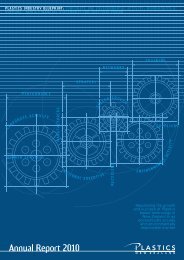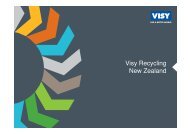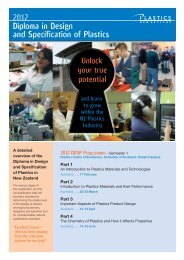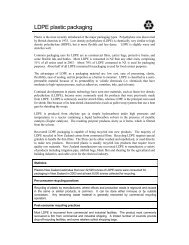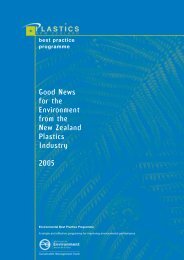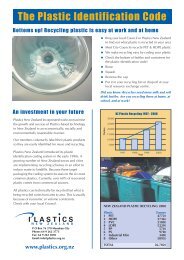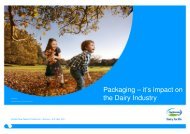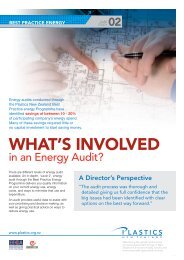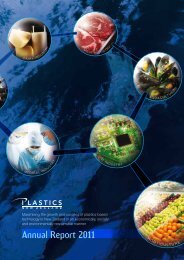Sustainable End-of-Life Options for Plastics in New Zealand
Sustainable End-of-Life Options for Plastics in New Zealand
Sustainable End-of-Life Options for Plastics in New Zealand
Create successful ePaper yourself
Turn your PDF publications into a flip-book with our unique Google optimized e-Paper software.
Appendices<br />
Appendix 1: Supplementary Data Table<br />
Amount <strong>of</strong> Material Recovered [<strong>in</strong> Tonnes] <strong>for</strong> Each <strong>of</strong> the Ma<strong>in</strong> Material Types<br />
Year PET HDPE PVC LDPE PP PS EPS Other Total<br />
(Incl. Film)<br />
2000 4,772 5,736 2,180 6,569 574 978 0 5,893 26,702<br />
2001 4,982 6,639 2,600 8,956 485 166 1 3,307 27,136<br />
2002 5,919 7,445 2,652 11,095 1,266 343 1 1,469 30,190<br />
2003 6,664 7,540 2,449 10,687 1,246 343 101 3,210 32,240<br />
2004 8,016 8,932 2,412 12,444 1,415 417 218 1,588 35,442<br />
Total 30,353 36,292 12,293 49,751 4,986 2,247 321 15,467 151,710<br />
Table 5: Breakdown <strong>of</strong> amounts <strong>of</strong> recovered plastic material from 2000-2004 by material type<br />
Appendix 2: Glossary<br />
Appendix 2.1 <strong>End</strong> <strong>of</strong> <strong>Life</strong><br />
The end <strong>of</strong> life is the f<strong>in</strong>al stage <strong>in</strong> the product life cycle where material has been used and disposed<br />
<strong>of</strong>. The material is then available <strong>for</strong> reprocess<strong>in</strong>g, which will help close the life cycle loop. See Figure 1.<br />
Appendix 2.2 Waste<br />
‘Any material, solid, liquid or gas that is unwanted and/or unvalued, and discarded or discharged by<br />
its owner’ (Source: M<strong>in</strong>istry <strong>for</strong> the Environment, Product Stewardship and Water Efficiency Labell<strong>in</strong>g<br />
Discussion Document, 2005)<br />
Appendix 2.3 Product Stewardship<br />
’Product Stewardship <strong>in</strong>volves producers, importers, brand owners, retailers, and other parties<br />
<strong>in</strong>volved <strong>in</strong> the life cycle <strong>of</strong> products accept<strong>in</strong>g responsibility <strong>for</strong> the environmental impacts <strong>of</strong> the<br />
products throughout their life cycle.’ (Source: M<strong>in</strong>istry <strong>for</strong> the Environment, Product Stewardship and<br />
Water Efficiency Labell<strong>in</strong>g Discussion Document, 2005)<br />
Appendix 2.4 Recyclable and Recoverable<br />
These terms have been used <strong>in</strong>terchangeably throughout the report. More specifically, ‘recyclable’<br />
refers to collected material that is able to be recycled, and ‘recoverable’ means material that is able<br />
to be recovered <strong>for</strong> recycl<strong>in</strong>g or any alternative end-<strong>of</strong>-life process<strong>in</strong>g.<br />
Appendix 2.5 Free-riders<br />
’“Free-riders” are non-participants who seek to benefit while not comply<strong>in</strong>g with the mechanisms or<br />
contribut<strong>in</strong>g to the costs [associated with the handl<strong>in</strong>g <strong>of</strong> materials at end <strong>of</strong> life].’ (Source: M<strong>in</strong>istry <strong>for</strong><br />
the Environment, Product Stewardship and Water Efficiency Labell<strong>in</strong>g Discussion Document, 2005)<br />
Appendices<br />
44



